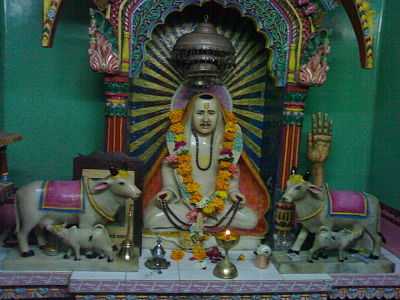Anjana Chaudhari
The Anjana, also known as Anjana Chaudhary,"Kalbi" is a Hindu caste found in Rajasthan, Gujarat, and Madhya Pradesh in India. They are also known as Patels, especially in Gujarat and Rajasthan, and Jagirdar, Zamindar or Chudhary in Rajasthan.[2] The Anjana Chaudhary's Caste Guru is Saint Shri Rajaramji Maharaj (avatar of Vishnu). The Big Temple and Ashram are in Rajasthan at Shikarpura(luni), near Jodhpur.
Belief
According to the ‘Bhat’ and "Charan" history books, the origin of Anjana Chaudhary is related to the eight sons of Sahastrarjun. When Parshuram went out to kill the kshatriyas, he came to Sahastrarjun, who was a powerful kshatriya king. In this battle, Sahastrarjun and 92 of his sons were killed. The remaining eight sons came under the shelter of goddess Arbuda on Mount Abu. The Goddess Arbuda protected them and Parshuram, would not hurt them on the condition that they give up their Shastra (weapons). Goddess Arbuda assured him that they would never again wield a weapon but instead serve Mother Earth. They turned to agriculture and are found in various parts of India to this day.
It is believed that the origin of the caste’s name comes from the goddess Anjani Mata, the mother of Lord Hanuman, as they were followers of the goddess. The Goddess Arbuda at Mount Abu is the kuldevi of Anjana Chaudhary.

Origin
The origin of the caste's name comes from the goddess Anjani Mata, the mother of Lord Hanuman, as caste members were followers of the goddess. According to their traditions the community originated from Mandsaur in Madhya Pradesh, from here they spread to southern Rajasthan and then to Gujarat. The Anjana still speak the Malvi dialect of Hindi.
In Rajasthan, they are divided into two broad territorial divisions: the Malvi and Gujarati. The Malvi Anjana are further divided into a number of exogamous clans such as the Fak, Shih, Kharon, Hun, Gardiya, Eit,Judar, Kuva, Kondli, Vagada, Kag, Bhuria, Mewar, Logar, Odh, Munji, Kawa, Tarak and United.[2]
Customs and Traditions of the Chaudhary Community
As Hindus, Chaudharies observe important customs related to ‘Simanta’ (pregnancy), ‘Upanayana’ (thread ceremony), ‘Vivah’ (marriage) and Death. Birth-Simanta, which corresponds to the Vedic ‘Samskara’ of ‘Simantonayana’, is popularly known as ‘Kholobharvo’, and is performed at the husband’s house to celebrate the woman’s first pregnancy. On the birth of a child, the midwife cuts its naval-cord and buries it in the corner of the compound in front of the house. The naming ceremony takes place on the twelfth day. The aunt (Foi) performs the naming ceremony today and names are given according to the zodiac signs for which a Brahmin is consulted.
Marriage ceremonies by the Chaudharies are traditionally conducted in accordance with the Central Asian customs. These customs have evolved since traditional times and differ in many ways. They attach a lot of importance to weddings and the ceremonies are very colorful and can go on for several days. The following steps are involved in a marriage like engagement, ‘Ganeshpujan’, ‘Varghoda,’ marriage, reception, etc.
Marriage is considered as ‘Samskara’ in the Hindusastra through which a person enters the ‘Grahasthashrama’ (householder’s stage). The marriage proposal usually comes from the girl’s side, in which socioeconomic status and education are chiefly taken into consideration. In the Chaudhari community, the father of the girl presents a one rupee coin during the betrothal ceremony.
Caste Guru-Saint Shri Rajaram ji Maharaj
Shikarpura Ashram is located at around 6 km away from Luni. Luni is a Tehsil in Jodhpur District of Rajasthan. This Ashram was established by Saint Raja Ram Ji Maharaj in the nineteenth century.
Mahants of Shikarpura Ashram are: Saint Deva Ram Ji Maharaj, Saint Kishna Ram Ji Maharaj & GURU Sujaramji Maharaj, Saint Dayaram. The ashram continues to serve the society from its establishment.
Festivals
Chaudhari people celebrate the following festivals with great fanfare –
• Raksha Bandhan (the bond of protection) celebrates the relationship between brothers and sisters. It is celebrated on the full moon day on the month of Shravana.
• Diwali is one of the most well-known festivals and is celebrated with great fanfare. Firecrackers and sweets accompany Diwali celebrations. Every house in the state is illuminated by electrical bulbs or candles. The festival can go on for four days.
• Holi is the festival of colours or love. It is celebrated to denote the arrival of spring. Furthermore, it is celebrated to mark the victory of the faith of Prahlada over the evil doings of Hiranyakashipu and Holika, who both tried to kill him.
• Navratri is the festival of the nine nights in honor of the Goddess ‘Ambaji’. People, irrespective of gender, caste and creed, congregate to perform their traditional dance called Garba and Dandiya Ras.
Sources
- Ajay Kumar Agnihotri (1985) : "Gohad ke Jaton ka Itihas" (Hindi), p. 63-71
References
- ↑ "Chaudharys of Gujarat (Anjana)". wordpress.com. Sagar Chaudhary. Retrieved 3/10/2014. Check date values in:
|accessdate=(help) - ↑ 2.0 2.1 People of India Rajasthan Volume XXXVIII Part Two edited by B.K Lavania, D. K Samanta, S K Mandal & N.N Vyas pages 49 to 52 Popular Prakashan